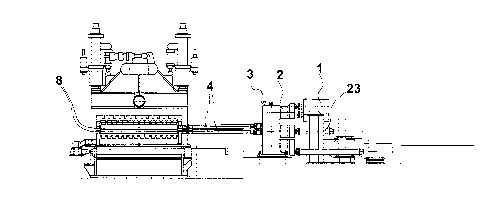Some of the information on this Web page has been provided by external sources. The Government of Canada is not responsible for the accuracy, reliability or currency of the information supplied by external sources. Users wishing to rely upon this information should consult directly with the source of the information. Content provided by external sources is not subject to official languages, privacy and accessibility requirements.
Any discrepancies in the text and image of the Claims and Abstract are due to differing posting times. Text of the Claims and Abstract are posted:
| (12) Patent: | (11) CA 2615951 |
|---|---|
| (54) English Title: | ROLLER ACTUATING DEVICE FOR MACHINES USED FOR PROCESSING METAL PRODUCTS |
| (54) French Title: | DISPOSITIF D'ACTIONNEMENT DE ROULEAUX DE MACHINES UTILISEES DANS LE TRAITEMENT DE PRODUITS METALLIQUES |
| Status: | Expired and beyond the Period of Reversal |
| (51) International Patent Classification (IPC): |
|
|---|---|
| (72) Inventors : |
|
| (73) Owners : |
|
| (71) Applicants : |
|
| (74) Agent: | SMART & BIGGAR LP |
| (74) Associate agent: | |
| (45) Issued: | 2014-01-07 |
| (86) PCT Filing Date: | 2006-07-20 |
| (87) Open to Public Inspection: | 2007-01-25 |
| Examination requested: | 2011-06-15 |
| Availability of licence: | N/A |
| Dedicated to the Public: | N/A |
| (25) Language of filing: | English |
| Patent Cooperation Treaty (PCT): | Yes |
|---|---|
| (86) PCT Filing Number: | PCT/EP2006/064454 |
| (87) International Publication Number: | WO 2007010021 |
| (85) National Entry: | 2008-01-18 |
| (30) Application Priority Data: | ||||||
|---|---|---|---|---|---|---|
|
Roller actuating device for flattening machines used for metal products in the
shape of sheet metal, strips or the like, also used with similar machines for
other applications, comprising a device for transmitting motion to driven
rolls (8) , extremely functional and capable of transmitting higher torques as
well as their independent control. Such device overcomes the frequent problems
concerning the space available for installing gimbal adapters. This can be
achieved by using adapters (4) provided with teeth which, with the same flange
diameter, are able to provide higher torques, and in any case, can be used in
any applications in which it is necessary to have reduced operating angles of
the adapters .
L'invention concerne un dispositif d'actionnement de rouleaux de machines à aplatir utilisées pour des produits métalliques en forme de tôles métalliques, de bandes, etc., et avec d'autres machines similaires conçues pour d'autres applications, qui comprend un dispositif qui transmet le mouvement aux cylindres entraînés, qui est extrêmement fonctionnel et capable de transmettre des couples plus élevés ainsi que leur commande indépendante. Un tel dispositif résout les fréquents problèmes relatifs à l'espace disponible pour l'installation d'adaptateurs de cardan, ce que l'on peut réaliser en utilisant des adaptateurs munis de dentures qui, avec le même diamètre de l'embase, peuvent fournir des couples plus élevés, et dans tous les cas, on peut les utiliser dans n'importe quelle application où des angles d'exploitation réduits des adaptateurs sont nécessaires. Le dispositif d'actionnement est beaucoup plus compact que celui que l'on utilise dans d'autres dispositifs courants. En outre, il réduit considérablement l'espace occupé par l'ensemble de la machine.
Note: Claims are shown in the official language in which they were submitted.
Note: Descriptions are shown in the official language in which they were submitted.

2024-08-01:As part of the Next Generation Patents (NGP) transition, the Canadian Patents Database (CPD) now contains a more detailed Event History, which replicates the Event Log of our new back-office solution.
Please note that "Inactive:" events refers to events no longer in use in our new back-office solution.
For a clearer understanding of the status of the application/patent presented on this page, the site Disclaimer , as well as the definitions for Patent , Event History , Maintenance Fee and Payment History should be consulted.
| Description | Date |
|---|---|
| Time Limit for Reversal Expired | 2023-01-20 |
| Letter Sent | 2022-07-20 |
| Letter Sent | 2022-01-20 |
| Letter Sent | 2021-07-20 |
| Common Representative Appointed | 2019-10-30 |
| Common Representative Appointed | 2019-10-30 |
| Inactive: Late MF processed | 2016-09-21 |
| Letter Sent | 2016-07-20 |
| Grant by Issuance | 2014-01-07 |
| Inactive: Cover page published | 2014-01-06 |
| Pre-grant | 2013-10-22 |
| Inactive: Final fee received | 2013-10-22 |
| Notice of Allowance is Issued | 2013-05-01 |
| Notice of Allowance is Issued | 2013-05-01 |
| Letter Sent | 2013-05-01 |
| Inactive: Approved for allowance (AFA) | 2013-04-29 |
| Amendment Received - Voluntary Amendment | 2013-02-19 |
| Inactive: S.30(2) Rules - Examiner requisition | 2012-08-24 |
| Amendment Received - Voluntary Amendment | 2011-10-05 |
| Letter Sent | 2011-07-07 |
| All Requirements for Examination Determined Compliant | 2011-06-15 |
| Request for Examination Requirements Determined Compliant | 2011-06-15 |
| Request for Examination Received | 2011-06-15 |
| Inactive: Cover page published | 2008-04-09 |
| Inactive: Notice - National entry - No RFE | 2008-04-07 |
| Inactive: Applicant deleted | 2008-04-07 |
| Application Received - PCT | 2008-02-09 |
| Inactive: First IPC assigned | 2008-02-09 |
| National Entry Requirements Determined Compliant | 2008-01-18 |
| Application Published (Open to Public Inspection) | 2007-01-25 |
There is no abandonment history.
The last payment was received on 2013-06-20
Note : If the full payment has not been received on or before the date indicated, a further fee may be required which may be one of the following
Please refer to the CIPO Patent Fees web page to see all current fee amounts.
Note: Records showing the ownership history in alphabetical order.
| Current Owners on Record |
|---|
| DANIELI & C. OFFICINE MECCANICHE S.P.A. |
| Past Owners on Record |
|---|
| None |